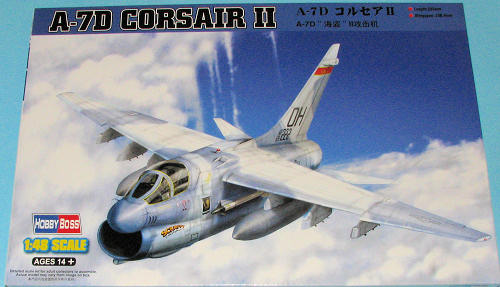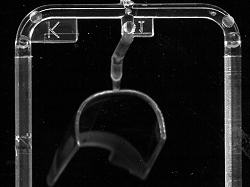
| KIT #: | 80344 |
| PRICE: | $69.95 MSRP |
| DECALS: | Two options |
| REVIEWER: | Scott Van Aken |
| NOTES: | Comes with full weapons load |

| HISTORY |
In the early 1960s, Secretary of Defense Robert McNamara prodded the Air Force to adopt not only the hugely successful F-4, but also the Navy's A-7 Corsair as a low-cost follow-on to F-105s until the troubled F-111 came online, and as a close-air support replacement for A-1 Skyraider. On 5 November 1965, the USAF announced that it would purchase a version of the A-7, designated the A-7D, for Tactical Air Command. The Air Force ordered the A-7D with a fixed high speed refueling receptacle behind the pilot optimized for the KC-135's flying boom rather than the folding long probe of the Navy aircraft. The most important difference from the preceding Navy versions was the adoption of the Allison TF41-A-1 turbofan, a license-built version of British Rolls-Royce Spey. With 14,500 lbf (64.5 kN) of thrust, the engine offered a considerable boost in performance. The M61 Vulcan cannon was selected in place of the twin single-barrel 20 mm cannon. In addition, avionics were upgraded. The YA-7D prototype with TF30 flew on 6 April 1968, with the first TF41 aircraft taking to the air on 26 September 1968. The aircraft were later updated to carry the Pave Penny laser spot tracker to add the capability to drop guided bombs. A total of 459 were built and assigned to tactical fighter wings of the Tactical Air Command (TAC). Many of these upgrades were adopted for the Navy A-7E which first flew about the same time as the A-7D.
The A-7 Corsair has the distinction of being the only United States single seat jet fighter-bomber of the 1960s that was designed, built, and deployed directly into the Vietnam War.
| THE KIT |
 The kit is nicely molded in the current style of lots of indented rivets. I found just a few sink areas on the outside of gear doors where there is a lot of internal detail. The kit has a well done cockpit with raised instrument details on the main panel and side consoles. Decals are also provided in case you wish to go that route. The seat is a bit plain looking and like most kits, could do with a more detailed replacement, or at least a harness.
The kit is nicely molded in the current style of lots of indented rivets. I found just a few sink areas on the outside of gear doors where there is a lot of internal detail. The kit has a well done cockpit with raised instrument details on the main panel and side consoles. Decals are also provided in case you wish to go that route. The seat is a bit plain looking and like most kits, could do with a more detailed replacement, or at least a harness.
The wheel wells are fully detailed and the intake goes back to the end of the cockpit area. Also detailed are the external avionics bays with covers that can be posed open. Now in the USAF, it was common to see some of these open. Full weapons pylons and a broad array of things to carry under the wings are provided. In fact, two sprues are nothing more than weapons. You get Sidewinders, Mk 80 series slick bombs with MERS, a pair of fuel tanks (which were frequently carried despite the Corsair II's excellent range without them), some more modern LGBs, a full set of Maverick missiles and some jamming pods. The instruction sheet includes a full load-out sheet to show where some of these things are carried. This sheet shows the fuel ta nks being carried on the two outer pylons. I believe this is wrong. From what I understand, only the inner pylons were plumbed for the drop tanks. At least, that is where I've always seen them carried.
nks being carried on the two outer pylons. I believe this is wrong. From what I understand, only the inner pylons were plumbed for the drop tanks. At least, that is where I've always seen them carried.
Two things about the kit struck me. One is that the intake doesn't seem round enough. looking at photos, it seems the kit intake is too flat on the bottom. Same with the canopy. It seems a bit too flat-topped. Much like the Monogram A-7A and if that was used for a basis for this kit, that explains much. They should have chosen the Fujimi 1/72 kit as they seem to have gotten it right. Here is an image of the canopy so you can judge for yourself. The canopy has a prominent mold seam running down the middle of it so it is something you'll have to sand away.
 Instructions are quite well done. There is an nice parts diagram with a listing of unused pieces. Paints shown are the usual Gunze references with generic names included. The insides of the equipment bays are listed as Interior Green. most photos I've seen are Chromate Yellow, but I have seen one or two USAF planes with these areas in Interior Green. The decals ar
Instructions are quite well done. There is an nice parts diagram with a listing of unused pieces. Paints shown are the usual Gunze references with generic names included. The insides of the equipment bays are listed as Interior Green. most photos I've seen are Chromate Yellow, but I have seen one or two USAF planes with these areas in Interior Green. The decals ar e very nicely printed and provide markings for two planes. There is also a second decal sheet (not shown) that provides markings for the weapons. One option is the box art plane from the 162 TFS of the Ohio ANG. This one is named "Scrappy" and I managed to get a photo of it at the 1989 Mildenhall air show. It is in the late two greys wraparound scheme.
e very nicely printed and provide markings for two planes. There is also a second decal sheet (not shown) that provides markings for the weapons. One option is the box art plane from the 162 TFS of the Ohio ANG. This one is named "Scrappy" and I managed to get a photo of it at the 1989 Mildenhall air show. It is in the late two greys wraparound scheme.
 The other is from the 23rd TFW sometime in the mid 1970s before the A-10 came on line. It is in a SEA wraparound scheme. The instructions show the use of the Pave Penny pod under the chin, but I believe it was rare to see regular USAF units with it. It certainly is not installed in this late 1979 photo of sister aircraft 74-1751 (lower left) . As you can see from the image of this plane (74-1752) in service with the 107 TFS, Michigan ANG during 1988, the aircraft lived a long and productive life. As a late note, I have had a couple of readers send me images of 23 TFW planes with the pod installed so it is your choice.
The other is from the 23rd TFW sometime in the mid 1970s before the A-10 came on line. It is in a SEA wraparound scheme. The instructions show the use of the Pave Penny pod under the chin, but I believe it was rare to see regular USAF units with it. It certainly is not installed in this late 1979 photo of sister aircraft 74-1751 (lower left) . As you can see from the image of this plane (74-1752) in service with the 107 TFS, Michigan ANG during 1988, the aircraft lived a long and productive life. As a late note, I have had a couple of readers send me images of 23 TFW planes with the pod installed so it is your choice.


| CONCLUSIONS |
So here is an alternative to the Hasegawa kit in the same scale. Both are about the same price, though the Hobby Boss kit comes with a full weapons load. That has to be weighed against the shape of the intake and canopy. Still, this kit has a lot to offer and should make into a very nice model.
| REFERENCES |
http://en.wikipedia.org/wiki/A-7D_Corsair_II
March 2010
If you would like your product reviewed fairly and fairly quickly, please contact the editor or see other details in the